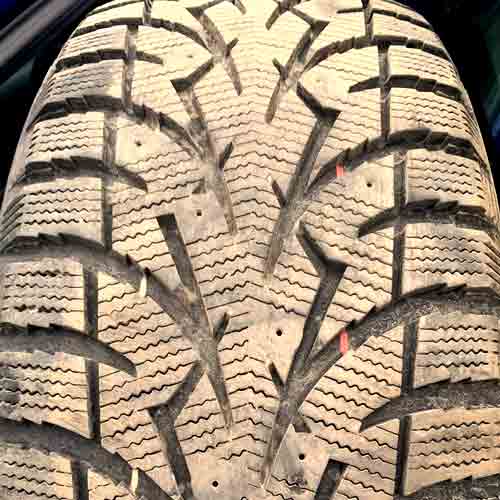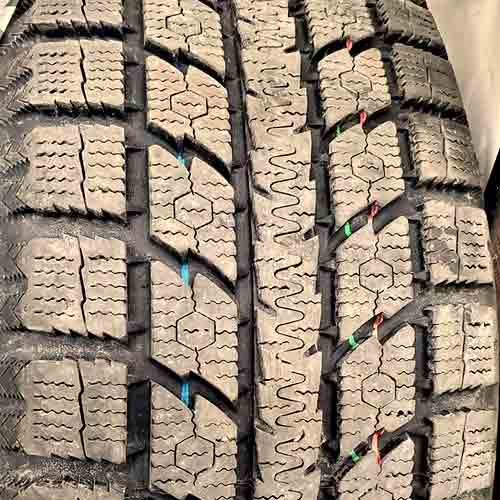Both Toyo Observe GSI 5 are the front-runners in the winter tire race, each demonstrating their own prowess to navigate icy terrains. As the snowflakes swirl, let’s see who leads in this wintry rally!

Table of Contents
Key Takeaway
- Wet Traction: The Toyo Observe GSI 5 has a superior wet grip due to its central rib pattern with zigzag slits, rectilinear and interlocking sipes, and snowflake-shaped slits. However, the G3 performs better in hydroplaning situations thanks to its wide channels and sweeping arms.
- Tread Life: The Toyo Observe G3, being lighter with closely-packed lugs, results in less friction during road contact and thus slower tread wear over time, compared to its heavier counterpart.
- Snow Performance: The G3 outperforms in soft snow conditions due to its aggressive directional tread pattern and numerous gaps and biters that trap snow particles effectively.
- Fuel Economy: The Observe GSI 5 offers better fuel economy due to its streamlined and longitudinally aligned ribs, leading to less rolling resistance.
- Comfort Levels: The G3 tends to produce more road noise due to its wider tread gaps. Conversely, the GSI-6 falls short in vibration absorption due to its harder tread compound. So its a tie.
- Dry Traction: The GSI 5 offers superior directional grip due to its continuous central rib and improved handling due to its compact pattern and lighter weight.
Wet Traction
When it comes to wet traction, two key components play a crucial role: the tread design and the rubber formulation. These elements shape how well the tire grips the road and resists hydroplaning, which are essential factors for optimal performance in wet conditions.
Let’s take a closer look at these dimensions.
Wet Grip
In terms of wet grip, the Toyo Observe GSI 5 showcases a central rib pattern with zigzag slits, accompanied by a variety of rectilinear and interlocking sipes, along with notches.
The tire’s surrounding blocks also feature snowflake-shaped slits and snow vices directed towards the shoulders.
These intricate structures allow this tire to absorb and expel water more effectively, creating a suction-like effect that enhances its overall wet grip.
On the other hand, the Toyo Observe G3, despite its aggressive siping design and multi-angled biters, falls slightly behind its bigger brother.

It shows slightly longer handling lap times on average, indicating a comparatively weaker wet grip performance.
Basically, sipes are just slits, which expand and contract, to create a suction.
And this suction, then suck in the water particles to clear away the path for the tread’s biters to grip in.
And the Toyo G3 feature sipes with less suction creating abilities.
So you get the upper hand on its newer generation.
Winner: Toyo Observe GSI 5
But, wait, what about the secondary part of the overall wet traction? Aquaplaning?
Hydroplaning Resistance
Hydro or aquaplaning is a hazardous situation that occurs when a layer of water builds up between the tire tread and the road surface, causing the tire to lose traction and “float” on the water.
And here, the Toyo Observe G3 demonstrates a more commendable performance.

This tire is basically equipped with wide channels and sweeping arms that enable higher hydroplaning speeds, both in straight-line driving and while taking curves.
With the network of channels, teh G3 efficiently disperses water in all directions, enhancing its overall resistance to hydroplaning.
Winner: Toyo Observe G3 Ice
Snow Performance
When it comes to performance in soft snow conditions, the Toyo G3 has a slight advantage.
It boasts numerous gaps and biters that effectively trap snow particles, promoting snow-to-snow interaction.
This trapping of snow creates a primary contact patch with the ground as the tire rotates, thereby improving traction since snow adheres more readily to itself than to rubber.
Additionally, the more aggressive directional pattern of the tire’s tread facilitates a paddling effect, scooping and propelling snow backward, generating forward momentum.
Conversely, the Toyo Observe G5 lacks these attributes. It employs a less aggressive overall pattern and doesn’t provide as effective snow-to-snow contact (mainly because of its central most continuous running rib).
Winner: Toyo Observe G3
Comfort Levels
Comfort in a tire primarily depends on the level of road noise and its ability to absorb vibrations.
Starting with road noise, which is caused by the interaction of air particles with the tread pattern, the Toyo Observe G3 leaves room for improvement.
In general, wider tread gaps produce higher noise levels, and this tire with relatively open tread design, falls short in maintaining a quieter ride, as air particles in the tread strike around more freely and with more force (generating louder sound-waves).
However, when considering vibration absorption, the Toyo Observe GSI-6 falls short.
The tire features a relatively harder tread compound, which isn’t able to soak up the shocks of the road as efficiently.
Winner: Both!
Fuel Economy
Fuel efficiency in a tire is closely linked to its tread design and overall weight, both of which contribute to rolling resistance.
The heavier tire with larger tread gaps causes increased flexing of the tire lugs during maneuvers such as cornering, braking, or accelerating.
And this flexing or deformation of the lugs results in extra energy consumption, which is the case with the Toyo Observe G3 Ice.
Conversely, the Toyo Observe G5, with its more streamlined and longitudinally aligned ribs, generates less rolling resistance. As a result, it offers better fuel economy compared to its counterpart.
Winner: Toyo Observe GSI 5
Dry Traction
Dry traction can be evaluated based on two factors: directional grip and handling. Let’s examine both aspects.
Directional Grip
Dry grip primarily relies on the central area of the tire’s tread, as it makes the most contact with the road.
(This is especially crucial for winter tires with their rounded contact patches and directional designs).
Anyways, so in this context, the Toyo Observe GSI 5 takes the lead with its continuous, wider central rib.
This design ensures uninterrupted interaction between the rubber and the road, resulting in shorter braking distances and indicating superior directional grip.
Conversely, the Toyo Observe G3 Snow falls short due to its missing continuous running rib in the middle, similar to its counterpart.
Winner: Toyo Observe GSI 5
Handling
The handling or cornering ability of a tire largely depends on the performance of its shoulder lugs.
And here, two factors come into play: the effectiveness of the lugs’ ground contact as the tire rotates and the degree of lug deformation during this process.
Having said that, in both aspects, the Toyo Observe G5 emerges as the winner.
Its compact pattern provides a larger contact patch with the ground, and due to its lighter weight, its lugs don’t excessively flex during cornering.
During cornering, most of the tire’s weight shifts toward the shoulders, and excessive bending of the lugs disrupts the balance between oversteer and understeer, resulting in slower steering response.
Therefore, due to its heavier construction and wider channels, the Toyo G3 records longer handling lap times.
Winner: Toyo Observe G5
Tread Life
The lifespan of a tire’s tread is significantly influenced by rolling resistance, which depends on the tire’s weight and rubber composition.
In this regard, the Toyo Observe GSI 5 faces some drawbacks.
Its heavier weight increases the pressure on the tread, leading to greater friction between the lugs and the road due to their wider spacing. The relatively softer rubber compound of the tire further exacerbates this issue.
On the contrary, the Toyo G3 is lighter and has closely-packed lugs, resulting in less friction during road contact and slower tread wear over time.
Winner: Toyo Observe G3
In Conclusion
Let’s bring things home.
In terms of wet traction, the Toyo Observe GSI 5 tire outshines, with its central rib pattern, zigzag slits, and various sipes that improve its wet grip. While its counterpart does better in hydroplaning resistance.
In terms of tread life, the G3 again falls behind, as it generates greater rolling friction, which by the way, also brings down the overall fuel economy.
In snow performance, the Toyo Observe G3 has a slight advantage. It has gaps and biters that trap snow particles, promoting snow-to-snow interaction and improving traction. Though on icy terrains, the G5 has the upper hand.
In terms of comfort, the Toyo Observe G3 falls short in reducing road noise due to its wider tread gaps. However, both tires have drawbacks in vibration absorption. The G3 features a harder tread compound that doesn’t absorb shocks efficiently, while the GSI 5 lacks in this aspect as well.